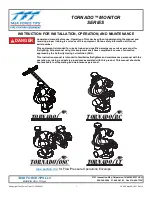
e6427rIR 03/17/17 Tri-Tech Medical Inc., 35401 Avon Commerce Pkwy., Avon, Ohio 44011 No. 99-0534
Tel. 1-800-253-8692 -or- 440-937-6244 Fax. 440-937-5060
Web site
E mail address:
5
Tri-Tech
Medical Inc.
Installation, Operating Instructions
for Sleep Lab Panel
Installation of Inlet and Outlet DISS Assemblies
Inlet and outlet DISS assemblies must be installed in accordance with NFPA99 or CSAZ7396.1. An internal nitrogen
purge must be used during the brazing operation.
The purge gas should flow away from the DISS body
. Brazing
alloys per appropriate standards must be used. Before brazing, wet rags must be wrapped around the tube extensions
next to the DISS body to prevent overheating and possible damage to the DISS O ring seals. Direct the flame away
from the DISS body. The DISS body temperature must not exceed 300 degrees F to prevent damaging the O ring
seals.
The system must be tested (per appropriate standards) to ensure that no cross-connections have been made.
The system must be tested (per appropriate standards) for leaks.
Note: Pressure in the system will increase or decrease with temperature rise or fall.
WARNING: Miss-connection of the gases could lead to serious or fatal injury to patients. Following
installation, DISS connections must be tested for cross-connection (per appropriate standards) to ensure
that the intended services are correctly connected to the appropriate service lines.
“X”
Adjustable
Flanges
Dust Cover
Plastic
Caps
Sleep Lab Panel Installation
1.
Tri-Tech Medical Sleep Lab Panels may be plumbed in either direction –
with the patient (use) side on the left or the right.
This saves the plumber
time and money.
2.
The rough-in (back box) is shipped with a cardboard dust cover installed. You
will need to remove the dust cover to install the rough-in and perform the
pressure test. The dust cover should be re-installed after the pressure test to
protect the DISS connections until the wall covering (drywall, paint etc.) is
complete.
3.
The DISS risers are shipped loose and must be installed in the back box.
4.
Adjustable depth mounting flanges (top & bottom) should be utilized to align
front edge of box to be flush with the drywall surface.
5.
The center of the rough-in box should be 60” in height above the finished floor.
Fasten the back box to horizontal braces installed between the studs so that the
front edge of the rough in box will be flush or slightly recessed with the finished
wall covering.
6.
Before brazing, remove the plastic tube caps from the DISS assembly (risers)
copper extensions. DISS assemblies must be installed in accordance with
“Installation of Inlet and Outlet DISS Assemblies” above.
7.
The system must be tested (per appropriate standards) to ensure that no cross-
connections have been made. The system must be tested (per appropriate
standards) for leaks. Note: Pressure in the system will increase or decrease with
temperature rise or fall.




























